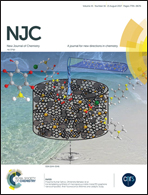A direct crossed polymerization of triphenylamines and cyclohexanones via C![[double bond, length as m-dash]](https://www.rsc.org/images/entities/char_e001.gif) C bond formation: the method and its bioimaging application†
C bond formation: the method and its bioimaging application†
Abstract
The effective polymerization process is very desirable in the field of macromolecule science. In this study, we present a facile synthetic method via aldol addition and condensation (AAC) that leads to the formation of fluorescent linear and branched polymers by cross coupling triphenylamines (TPA) and cyclohexanones (CYC) via C![[double bond, length as m-dash]](https://www.rsc.org/images/entities/char_e001.gif) C bond formation. The methodology has the advantage of easy operations, mild reaction conditions, and high yield. Via the analysis of NMR, FT-IR, GPC, PL, UV, SEM, and theoretical calculation, the structure, physical properties, and optical behaviors of both polymers were well-characterized. The understanding of cell transplantation, migration, division, fusion, and lysis is a very challenging task. In this study, the linear polymer (LP) exhibits excellent biocompatibility and low cytotoxicity, which can be readily internalized by living cells in a noninvasive manner. The images of MPC5 cells indicate that LP can be a promising emissive fluorescence probe for bioimaging application.
C bond formation. The methodology has the advantage of easy operations, mild reaction conditions, and high yield. Via the analysis of NMR, FT-IR, GPC, PL, UV, SEM, and theoretical calculation, the structure, physical properties, and optical behaviors of both polymers were well-characterized. The understanding of cell transplantation, migration, division, fusion, and lysis is a very challenging task. In this study, the linear polymer (LP) exhibits excellent biocompatibility and low cytotoxicity, which can be readily internalized by living cells in a noninvasive manner. The images of MPC5 cells indicate that LP can be a promising emissive fluorescence probe for bioimaging application.
![Graphical abstract: A direct crossed polymerization of triphenylamines and cyclohexanones via C [[double bond, length as m-dash]] C bond formation: the method and its bioimaging application](/en/Image/Get?imageInfo.ImageType=GA&imageInfo.ImageIdentifier.ManuscriptID=C7NJ01407D&imageInfo.ImageIdentifier.Year=2017)


 Please wait while we load your content...
Please wait while we load your content...
![[double bond, length as m-dash]](https://www.rsc.org/images/entities/h2_char_e001.gif) C bond formation: the method and its bioimaging application
C bond formation: the method and its bioimaging application